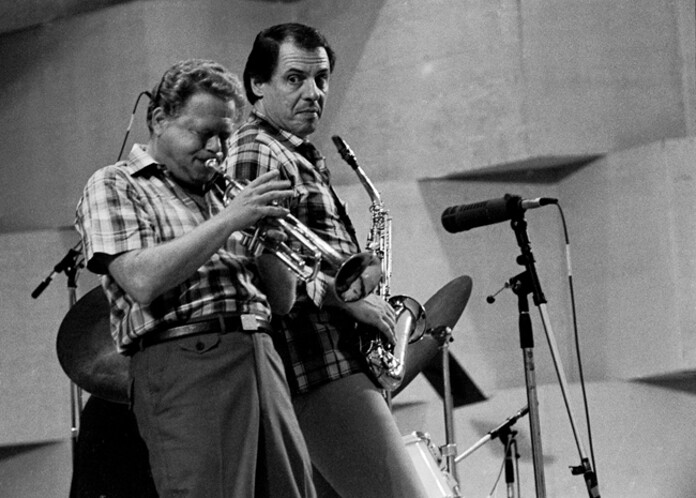In the language of jazz, “doubling” means playing more than one instrument (not at the same time, c.f. Wilbur Sweatman and Rahsaan Roland Kirk). Doubling isn’t that unusual. For example, many people play trumpet and fluegelhorn, but those horns are very similar and are played essentially the same way. Although most saxophonists specialize in one sax, many play other members of the sax family when it’s called for—not that difficult, thanks to the clever system that Adolphe Sax invented. Many saxophonists also play flute—a different embouchure and a bit of a stretch, but still expected for professionals. More credit might be due sax players who can credibly double on clarinet, an instrument whose fingering system is different enough to provoke frustrated grumbles from sax players.
Then, there are people who play credible piano, apart from whatever horn they play—this has become pretty de rigeur (Dizzy Gillespie was a prime mover in this trend). And many horn players also sing. Again, not real doubling. Lower brass players often double on trombone and tuba/euphonium. This is more challenging, as you have to master both slide and valves. But, it’s akin to playing stand-up bass and electric bass—different and still doesn’t satisfy the criteria I set up for the rare cohort I’m singling out.
I realize I might get in trouble with some folks by, as they might say, putting a premium on virtuosity over expressiveness. There are a bunch of musicians who pick up a wide variety of instruments on which they have little technique; the idea being that playing an instrument out of your usual ballpark can take you in new directions—“another voice.” A key person in that movement was alto saxophonist Ornette Coleman; also a sometime violin and trumpet player. He was an early influencer in the art/diy band movement that was in part a response to the “professionalization” of art in the U.S. Would that we had the kind of rituals that would allow us to make music as a natural part of our daily lives, without fear of making mistakes. I’m always in favor of giving people who lack craft on an instrument the chance to participate in a musical situation—but in convivial social circumstances, not onstage.
So, the musicians I’m talking about play instruments from two completely different families—trumpet, reed, percussion, and strings—with a high level of technical competence. With these admittedly stern criteria, we can narrow the field down to just a few score players, who seem to be gifted with such talent they could probably make convincing music with three lima beans and a tube of toothpaste.
I’ll start with Ray Nance (aka “floorshow”), a man who played violin, trumpet, and danced—as his boss Ellington might say—divinely. Then, you have Benny Carter, basically a contemporary of Nance, who, aside from writing and arranging, played beautiful alto sax and also really knew his way around the trumpet. How about Jimmy Dorsey, who started on trumpet and moved to reeds, but managed to retain his trumpet chops. Bobby Hackett, whom we know as a great cornet player actually started professionally as a guitarist. Then there’s Adrian Rollini, a fine bass sax player who doubled on vibes.
Slightly younger than the above and on the Latin side was Mario Rivera, who played with Machito, Sonny Stitt, and many others and who mastered a vast array of brass, reed, and percussion instruments. I’m going to single out one more musician, who arguably attained a higher level of technical expertise in two families of instruments than anyone else on this list-and swung like a beast: Ira Sullivan, who played bop/post-bop, the most demanding jazz style, on both trumpet and saxophones.

Here are some others, in no particular order, who deserve special notice: Brad Gowans (valve trombone, clarinet), Dick Wetmore (violin, bass, trumpet), Sonny Durham (guitar, trombone), Don Thompson (bass, vibes, piano), Ray Perry (alto, clarinet and violin).
Sidney Bechet doubled on clarinet, soprano sax, tenor sax, piano, bass, and drums on the very first multi-track recording in the history of jazz: “The Sheik of Araby” / “Blues Of Bechet” (1941). Benny Goodman plays cornet on “Jungle Blues” with Benny Goodman’s Boys in 1928.
Pete Brown played alto but also picked up trumpet for a 1939 Leonard Feather-organized Decca session: “Tempo Di Jump.” Toots Thielemans (guitar, harmonica), Harry James (trumpet, drums-when Buddy Rich sang), Australian James Morrison (you-name-it).
Ray Perry (violin, alto, clarinet), Don Elliott (trumpet, mellophone, vibraphone), Tom Baker (brass and reeds), Joe Mcphee and Howard Johnson (doubling all reeds or all brass). Andy Stein (baritone, tenor sax, and violin), Jack De Johnette (piano, drums, bass), Nicholas Payton (bass, drums, piano).
Jazz is a difficult enough style to master on one instrument. Those who have demonstrated mastery on different families of instruments deserve our vociferous acclaim. If I’ve missed someone you think should be in this select group, let me know.
Steve Provizer is a brass player, arranger and writer. He has written about jazz for a number of print and online publications and has blogged for a number of years at: brilliantcornersabostonjazzblog.blogspot.com. He is also a proud member of the Screen Actors Guild.





















